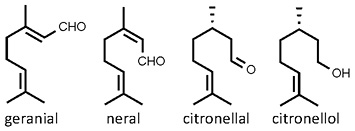 Cymbopogon citratus
Cymbopogon citratus
lemongrass
Back to “Culinary herbs: lemongrass (Cymbopogon citratus)*”
Cymbopogon citratus (DC.) Stapf (Poaceae); sitroengras (Afrikaans); xiang mao coa (Chinese); verveine de Indes (French); Lemongras, Zitronengras (German); sereh (Indonesian); citronella (Italian); remon gurasu (Japanese); serai (Malay); sontol (Spanish); takrai (Thai); xa (Vietnamese)
DESCRIPTION The finger-sized fleshy leaf bases and young stems are white to pale green and often slightly purplish, especially when viewed in longitudinal section.
THE PLANT Lemongrass is a robust perennial tuft with thick stems and broad, bluish-green, aromatic leaves. It is a cultigen that rarely forms flowers.1 This aromatic grass is often confused with similar-looking grasses that are commercial sources of essential oil.2 These are most accurately identified by their main chemical constituents (see Notes). Malabar lemongrass (C. flexuosus) is the source of East Indian lemongrass oil. It is sometimes used in Asian dishes in the same way as lemongrass. Ginger grass, palmarosa or rusha (C. martinii) has essential oil that is very similar to geranium oil. Two others are Ceylon citronella grass (C. nardus) and Java citronella grass (C. winterianus).
ORIGIN Southern India and Sri Lanka, as well as Malaysia1 have been proposed as likely candidates, but the exact geographical origin of lemongrass has remained unknown. It is mainly grown and used in Bali, Cambodia, Indonesia, Laos, Malaysia, Singapore, Sri Lanka, Thailand and Vietnam.
CULTIVATION Lemongrass is propagated by division of the clumps. The crop requires regular watering and a warm or tropical climate, as it is frost-tender.
HARVESTING Young stems are broken off by hand and the leaves trimmed and discarded.
CULINARY USES Lemongrass is an essential component of Asian cooking. The flavour is subtle and never dominates. It is particularly well known as a flavour ingredient of “lemongrass soup” and the famous tom yum. There are many variants of this “spicy and sour” soup in Thailand and Laos. The inner fleshy part of the stem may be finely sliced or pounded to a paste and eaten raw.3 When used as a culinary herb, the whole stem is often bruised before adding it to the dish. It can be removed later, after the flavour has been released. Lemongrass is used in a wide variety of dishes, including curries, stir-fries, soups and stews, particularly those based on fish, seafood and poultry. It is an important ingredient of spice mixtures, spicing liquors and sauces. Stalks are sometimes used as skewers for prawns or seafood satay.3 Lemongrass may be added to tea for flavour, or it can be mixed with lemon verbena and lemon balm to make lemon tea.
FLAVOUR COMPOUNDS Lemongrass is a traditional source of natural citral, which is a mixture of geranial and neral (ca. 40% of each).4 The subtle lemon flavour is ascribed to these two main ingredients.

NOTES Cymbopogon flexuosus oil is similar to lemongrass oil (dominated by citral), while so-called citronella oil, obtained from C. nardus and C. winterianus, has mainly citronellal, with smaller amounts of geraniol and citronellol. Palmarosa oil, distilled from C. martinii, yields almost pure geraniol (and is a substitute for oil of roses).
1. Burkill, I.H. 1966. A dictionary of the economic products of the Malay Peninsula, Vol. 1, pp. 724–728. Crown Agents for the Colonies, London.
2. Mabberley, D.J. 2008. Mabberley’s plant-book (3rd ed.). Cambridge University Press, Cambridge.
3. Hutton, W. 1997. Tropical herbs and spices. Periplus Editions, Singapore.
4. Pino, J.A., Rosado, A. 2000. Chemical composition of the essential oil of Cymbopogon citratus (DC.) Stapf. from Cuba. Journal of Essential Oil Research 12: 301–302.